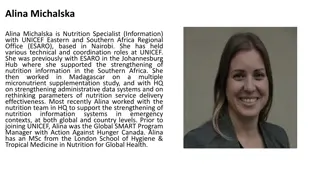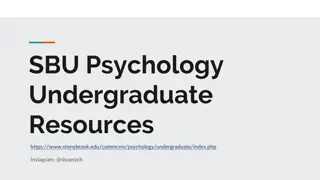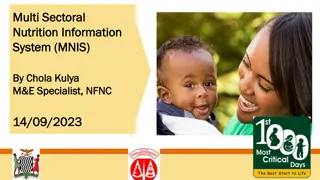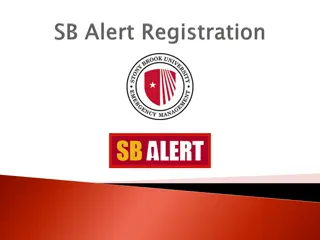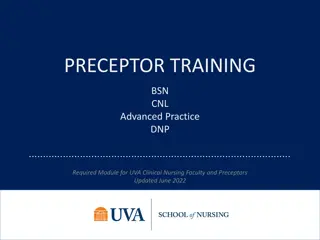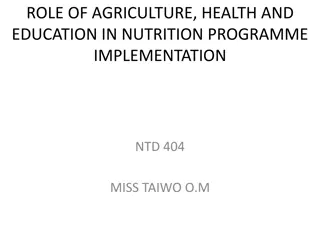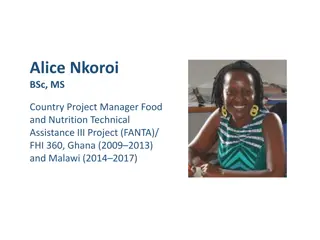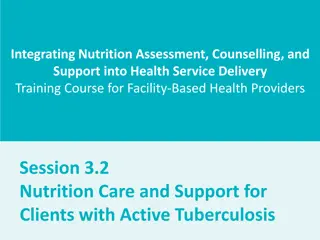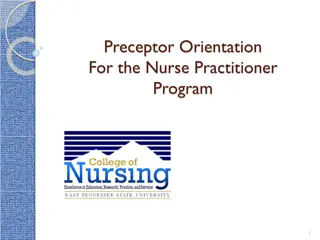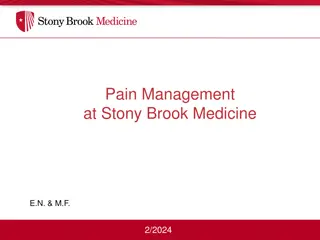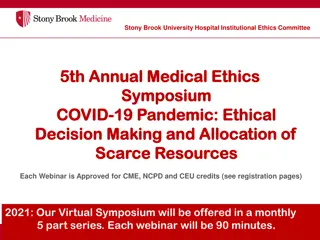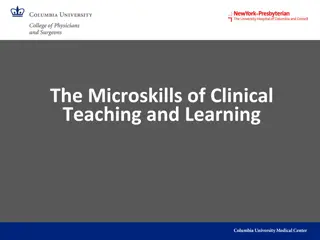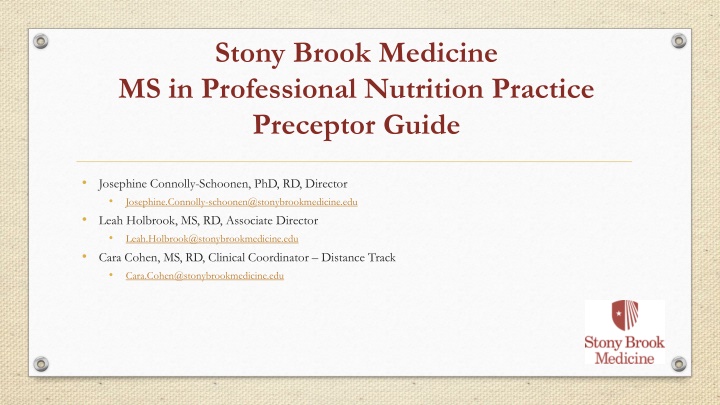
Preceptor Guide for Stony Brook Medicine MS in Professional Nutrition
This guide provides essential information for precepting students in the Stony Brook Medicine MS in Professional Nutrition program. Learn about program benefits, curriculum details, and opportunities available to volunteer faculty members.
Download Presentation

Please find below an Image/Link to download the presentation.
The content on the website is provided AS IS for your information and personal use only. It may not be sold, licensed, or shared on other websites without obtaining consent from the author. If you encounter any issues during the download, it is possible that the publisher has removed the file from their server.
You are allowed to download the files provided on this website for personal or commercial use, subject to the condition that they are used lawfully. All files are the property of their respective owners.
The content on the website is provided AS IS for your information and personal use only. It may not be sold, licensed, or shared on other websites without obtaining consent from the author.
E N D
Presentation Transcript
Stony Brook Medicine MS in Professional Nutrition Practice Preceptor Guide Josephine Connolly-Schoonen, PhD, RD, Director Josephine.Connolly-schoonen@stonybrookmedicine.edu Leah Holbrook, MS, RD, Associate Director Leah.Holbrook@stonybrookmedicine.edu Cara Cohen, MS, RD, Clinical Coordinator Distance Track Cara.Cohen@stonybrookmedicine.edu
First and Foremost Thank you for partnering with us on the essential task of training the next generation of registered dietitians/nutritionists!
Table of Contents Perks to precepting for Stony Brook University MS in Professional Nutrition Practice Program Description Program Vitals Some brief reminders Pertinent policies and procedures Graduation requirements to earn a Verification Statement Student and SBU Faculty Responsibilities Precepting tips
Benefits of Precepting Volunteer faculty appointment in the Department of Family, Population and Preventive Medicine Access to Stony Brook Medicine library Access to electronic data bases, search engines and e-journals Access to virtual SINC Site which provides a way to access site-licensed, academic software titles directly from your personal computers; programs include (among others): Microsoft Office Suite 2016, SPSS Statistics, SAS, ArcGIS, EndNote; use the link below with your Net ID https://it.stonybrook.edu/services/virtual-sinc-site Associated academic status and teaching credentials Invitation to Nutrition Division Journal Clubs (continuing education credits) virtually January, February, April, May, July, August, October, and November; 2nd Tuesday of month from noon to 1:00pm Annual Preceptor Appreciation Continuing Education Event The nutrition-focused physical examination Our students obtain this skill that can be brought back to your facility Services students can give back Quality assurance or performance improvement projects In-services, in-depth literature reviews Case studies (preceptors can earn CPE credits for attending such presentations) Development of patient education materials and/or marketing materials Continuing professional education credits ( leadership activity ) for serving as a preceptor 3 CPEUs/year and maximum 15 CPEUs/5 year recertification cycle
Program Description & Curriculum It is the mission of the Stony Brook University s Professional Nutrition Practice Graduate Program to prepare graduates for practice as registered dietitian nutritionists to promote health and wellness among patients and communities through evidence-based, culturally- competent and nutrition programs and services. The 16-month MS PNP program combines online coursework with supervised experiential learning hours: o Coursework (33 credits) o Supervised Experiential Learning (SEL) Rotations (1022 hours and 17 credits)
Supervised Experiential Learning (SEL) Rotations o Rotation types: o 150-hour food service management rotation o Winter semester (year 1) o 150-hour community nutrition & public health rotation o Spring semester (year 1) o 487.5-hour advanced nutrition therapy rotation oSite 1: Students must rotate at least 262.5 hours at a Joint Commission or other nationally accredited acute care facility. Large or small community hospitals are examples of sites for Site 1. o Site 2: Remainder of the total hours to be completed in a second clinical site. Examples include long term care facility, outpatient health care center, bariatric center, diabetes center, dialysis center and/or an eating disorder center. o Summer semester (year 1) and Fall semester (year two) o 62.5-hour research and quality improvement rotation o Fall semester (year two)
Some Brief Reminders Each student is required to have personal health insurance and professional liability insurance For each SEL there are program assignments to be completed with the following: List of competencies students will acquire while completing the SEL Planned learning activities designed to assist students in obtaining competencies; each matched to specific competencies Checklist to facilitate initial meeting with student to plan specific learning activities and consider dates/timeline Evaluation preceptor(s) completes of student; this is competency based and asks preceptor(s) to determine if student met SEL associated competencies. If you have concerns about student meeting competencies please contact the Director, Associate Director or Coordinator Students complete time sheet and requests your review and approval
Selected Policies: Time and Attendance Please discuss with students how you would like them to report sick days or request a day off (i.e. for family obligation), as well as attendance in inclement weather during the first day or so of the rotation Students are required to complete the minimum number of hours determined for each SEL. How the student makes-up the hours is determined by the preceptor With your staff on a weekend day(s) or longer weekday hours is possible Students are required to notify the Program Administrator of any lateness or days missed, as well as arrangements made with preceptors to make up time. Students must submit time and attendance sheets for each SEL to Brightspace (Stony Brook University s learning management system) Students are required to complete accurate time sheets, and present to preceptors for signature Misrepresentations are grounds for dismissal from the program As a student, completing supervised experiential learning courses and associated hours must not be used to replace employees.
Selected Policies: Dress Code Students should inquire about appropriate dress at each rotation site. If an student is dismissed for the day due to inappropriate dress, the preceptor will determine how the time is made up. Suggested dress guidelines are as follows: In any food service area, stockings must be worn if wearing a dress or skirt. Socks or stockings must be worn with pants. No low-cut necklines or shirts that show midriff; no tank tops or camisoles No excessively baggy or low-riding pants Closed-toe shoes are required; no flip-flops at any site Fingernails are to be neatly trimmed and maintained at a reasonable length. Artificial nail enhancements are not to be worn as per Stony Brook Administrative Policies and Procedures. No large earrings or nail polish in food service areas Facial jewelry may need to be removed at some sites Inappropriate body art may need to be covered at some sites Hair style or color cannot interfere with your duties and responsibilities Professional and neat attire at all times Lab coats should be carried with you at all times. Lab coats must be clean and pressed at all times.
Selected Policies: Cellular Phones Students are required to inquire about the cellular phone policy at each rotation site. Cellular phones may be carried to sites but the student is to follow the policy of that specific site. Selected Policies: Policy Regarding Influenza Students are expected to follow guidance from institutions in which they are rotating for supervised experiential learning.
Selected Policies: Academic Standing ACADEMIC STANDING PANEL Chair Judiciary Officer, Dietetic Internship, MS in Nutrition and MS in Professional Nutrition Practice Director, Nutrition Division and MS in Professional Nutrition Practice Director, Dietetic Internship Associate Director, Graduate Nutrition Programs Clinical Coordinator, MS in Professional Nutrition Practice Nutrition Division Faculty Member* Non-Stony Brook University Preceptor* Recent Alumnus of graduate nutrition program A student's academic standing is subject to university standards and to the policies of the program. A student needs to be in good standing to graduate. If a student fails to maintain good academic standing, the student may be subject to probation, suspension or termination. Students have a right of appeal to challenge any change in academic standing. Cases of academic dishonesty can also affect a student s academic standing and are addressed in the Academic Dishonesty Policy. Requirements to maintain good academic standing: 1. Maintain a GPA of 3.0 or greater. 2. Receive a grade of C+ or better in all non-SEL courses and a grade of B- or better in all SEL courses. 3. Adhere to professional codes of ethics, exhibit sensitivity to patient and community needs, and demonstrate appropriate professional behavior and demeanor.* This includes the following: appropriate and accurate charting, maintaining patient/client confidentiality, seeking appropriate supervision; appropriately representing role as student, maintenance of professional attitude and appearance, accurately representing attendance and, punctuality, as well as ability to work with and relate to peers and other members of the health care team. *Examples of inappropriate behavior may include the inability to respond to constructive criticism, failure to recognize the impact of verbal/non-verbal communication without appropriate modification, inaccuracy of self-assessment, and inability to adapt to change.
Selected Policies: Academic Standing, continued A student who does not meet the standards set forth in the above section shall be placed on probation: The student will meet with the Associate Director and Associate Director to: Discuss documentation of performance or behavior not consistent with criteria for meeting good academic standing Determine the course of action required for remediation, which may include: redesign of the student s schedule (including the rescheduling of a failed SEL course, which may require distance students securing a new site for additional hours). Scheduling of repeated SEL course will be dependent upon preceptors availability. activities to assist the student in achieving the necessary competencies and performance level, i.e. through reading and writing assignments, as well as additional hours and activities in SEL courses. activities/readings/narrated PowerPoints to assist student to re-write a module for a passing grade. The meeting will conclude with agreement on a remediation plan, inclusive of a timeline, that will be signed by student, Program Associate Director, and the Program Director. This plan will be forwarded to the Chair of the Academic Standing and Disciplinary Ad Hoc Committee. If a student is not able to advance their academic standing, subsequent action may include suspension or termination If terms are met the student will be returned to good academic standing, and will be notified by email.
Student and SBU Faculty Responsibilities Students Be prepared for SELs; review appropriate material from Brightspace; review syllabus and assignments (including associated competencies) Assume responsibility for own learning and be self-directed; review competencies to be achieved during the rotation Demonstrate professionalism timeliness, appropriate dress, organization, respect for co-workers, teamwork, flexibility, calmness, patience Be respectful of preceptors time and willingness to volunteer as a preceptor; recognize their need to prioritize patient-care and/or other responsibilities Have realistic expectations and recognize that there may be some down-time, bring reading material; recognize that some skills will take additional experience to master Be willing to stay late on occasion, as most professional do so Be ready to focus and prioritize your rotation experience; get adequate sleep and practice lifestyle behaviors that optimize their health SBU Faculty Review and grade SEL course assignments Provide summarized feedback from student Notify preceptors of changes in policy or curriculum Be available to preceptors when questions/concerns arise; address concerns in a timely fashion Providing continuing professional education opportunities annually Handle situation regarding warnings/probation and if necessary retract student not in good standing
Tips to Being an Effective Preceptor Provide an orientation to your site and clear directions for assignments Give students specific feedback using the feedback sandwich , i.e. provide a positive evaluative comment, followed by constructive criticism, following by a second positive evaluative comment. Plan for progression of learning, starting with more basic cases with heavy supervision to more complex cases with minimal supervision Provide amble opportunities for students to practice skills and demonstrate knowledge Aim for a teachable moment most days, in which you relate theory/concepts to cases; assign student to look up such concepts and report back to you at a given time Assign projects that benefit both the student and the department/facility Pace students, provide practice opportunities, and promote problem solving skill development Give case specific comments relate theory and basic science to the case Offer professional support and encouragement as students need this from their preceptor. Professional support helps provide conditions for students to learn and develop professionally. The focus is kept on client-centered care rather than on students inexperience. For more tips take the FREE CDR Preceptor Training Course; 8 CPEUs (this will take a few hours, however, you can complete one module at a time)
Challenging Students In the event you have a challenging students (rare but possible) Contact Program Director, Associate Director or Clinical Coordinator as soon as you have any concerns with a student, including their knowledge base, professionalism, attitude, etc. Together, we will develop an individualized plan, which may include: Virtual meeting(s) with student Academic remediation plan at rotation site
Valuable Partners We know precepting is a choice and we value your time We strive to be an effective partner and support/facilitate your precepting efforts We also strive to give back providing you with resources and training to facilitate the work you do and your mission! Please let us know if we can assist you!

